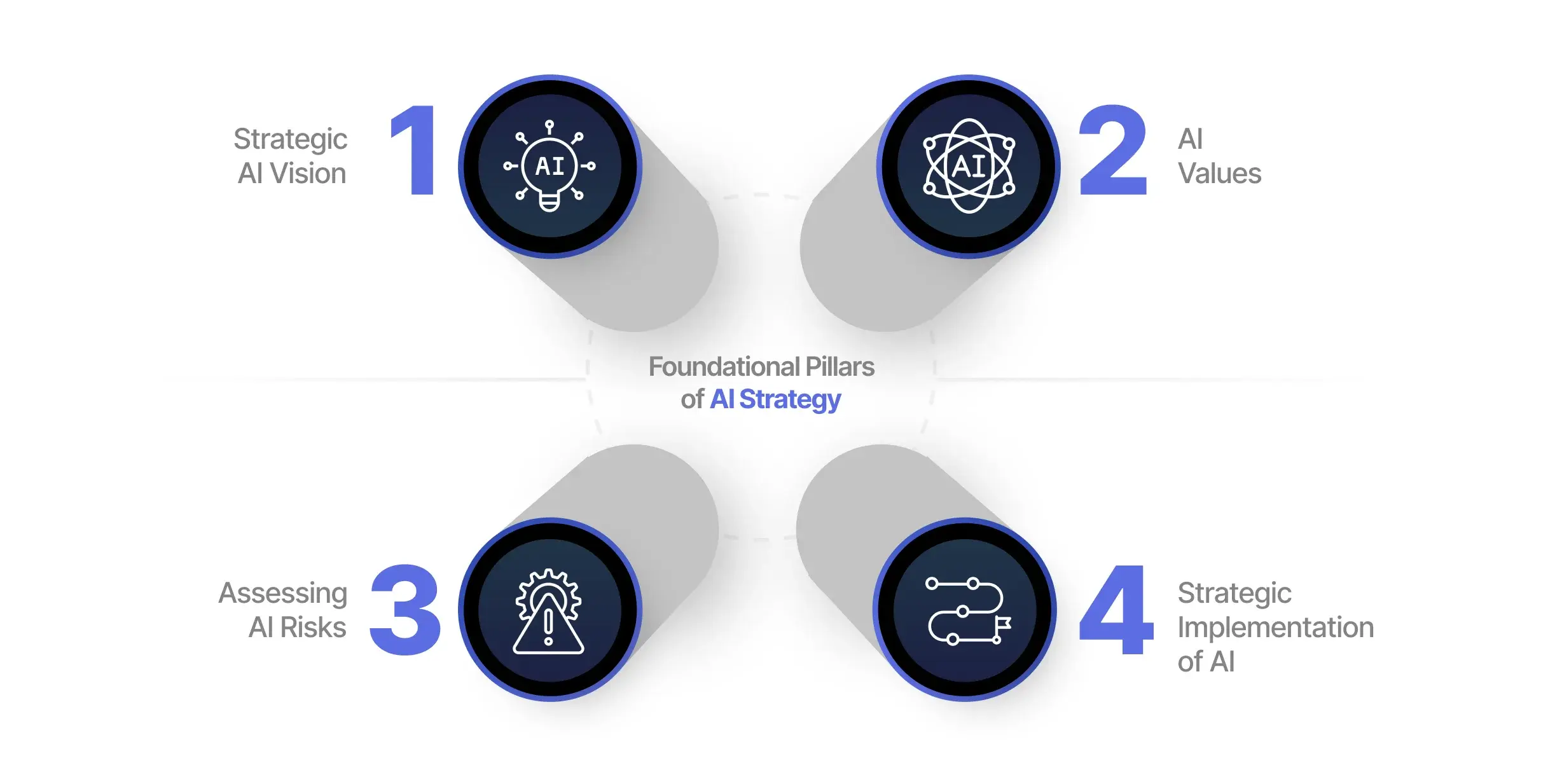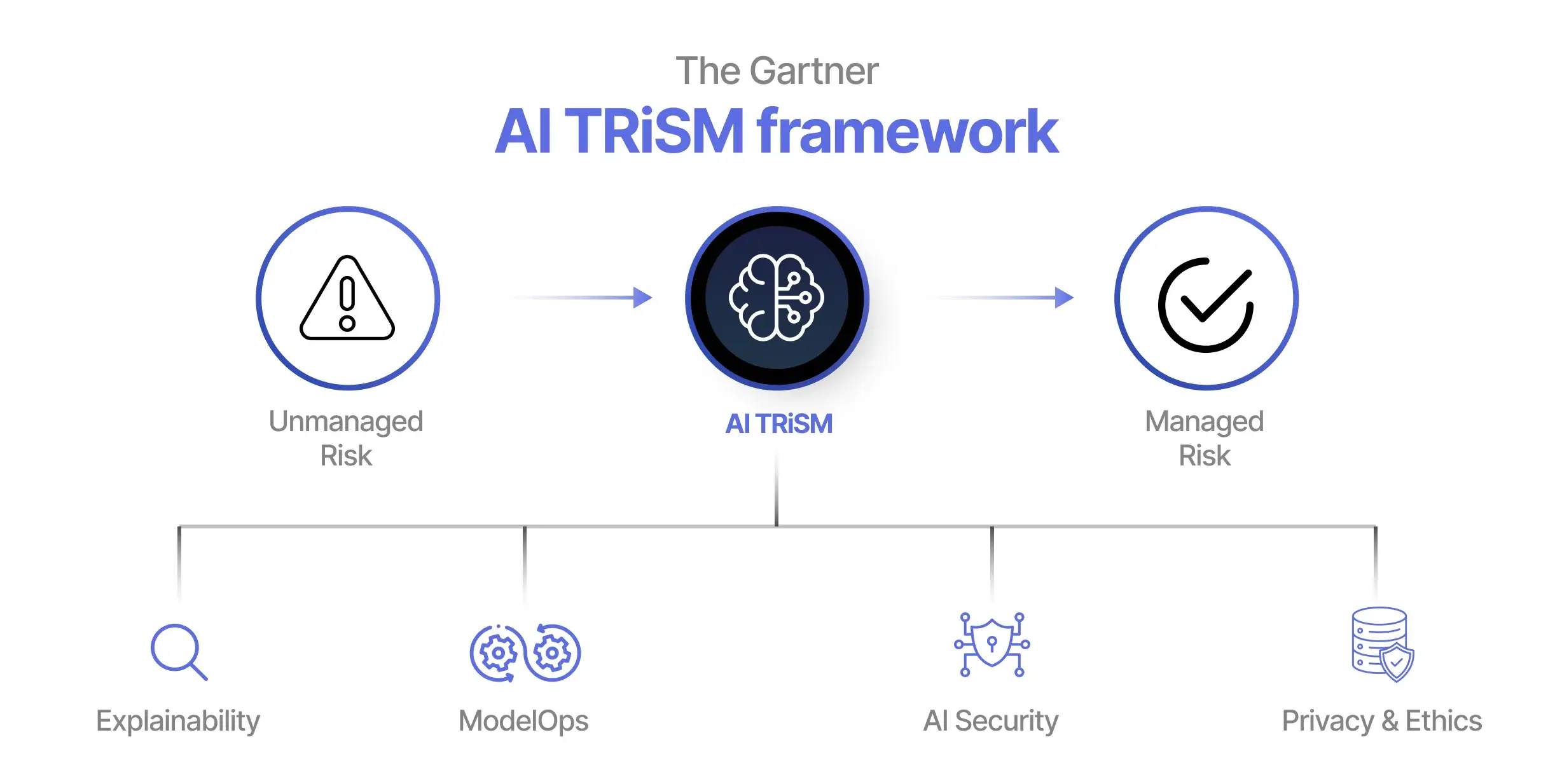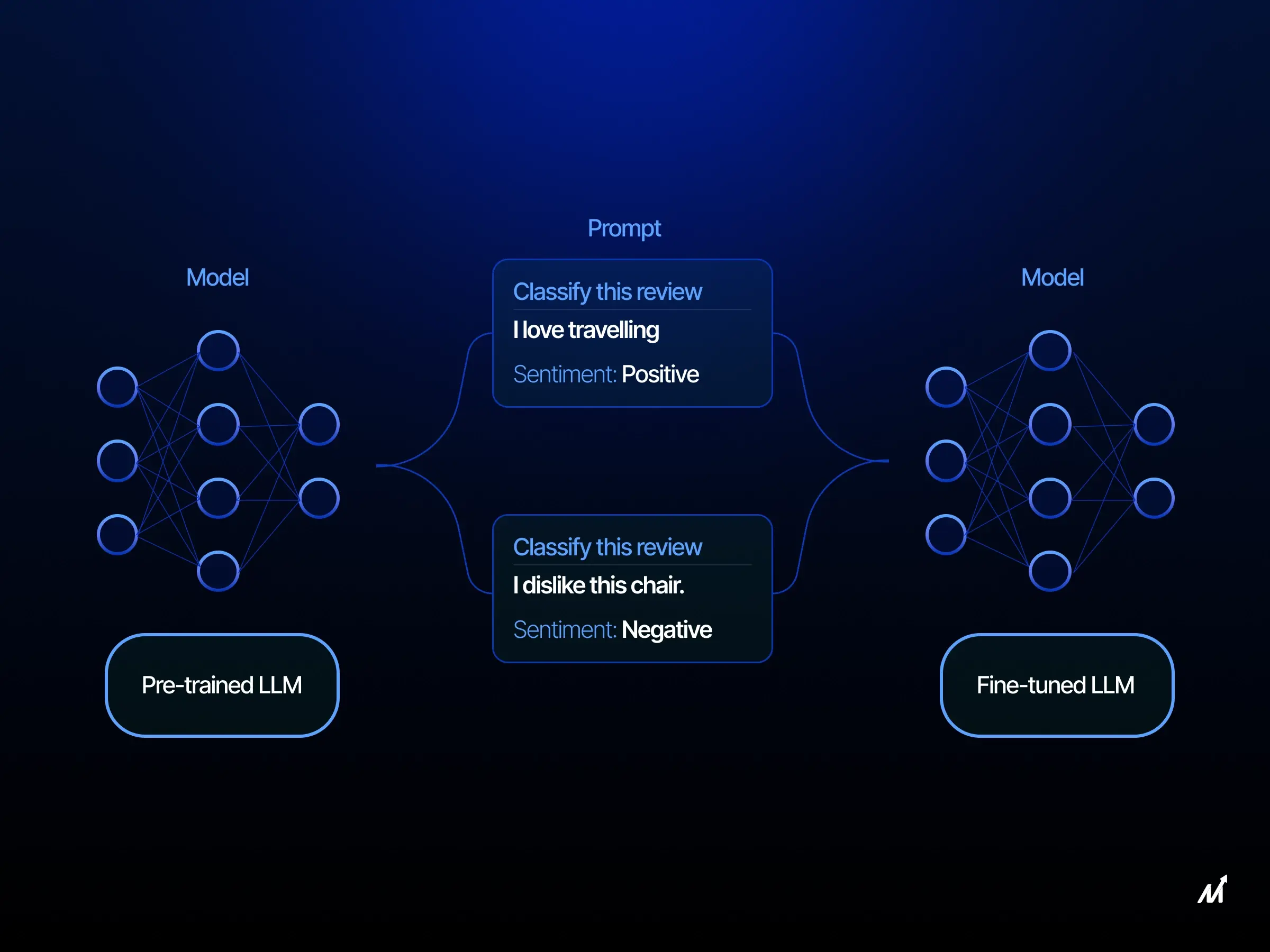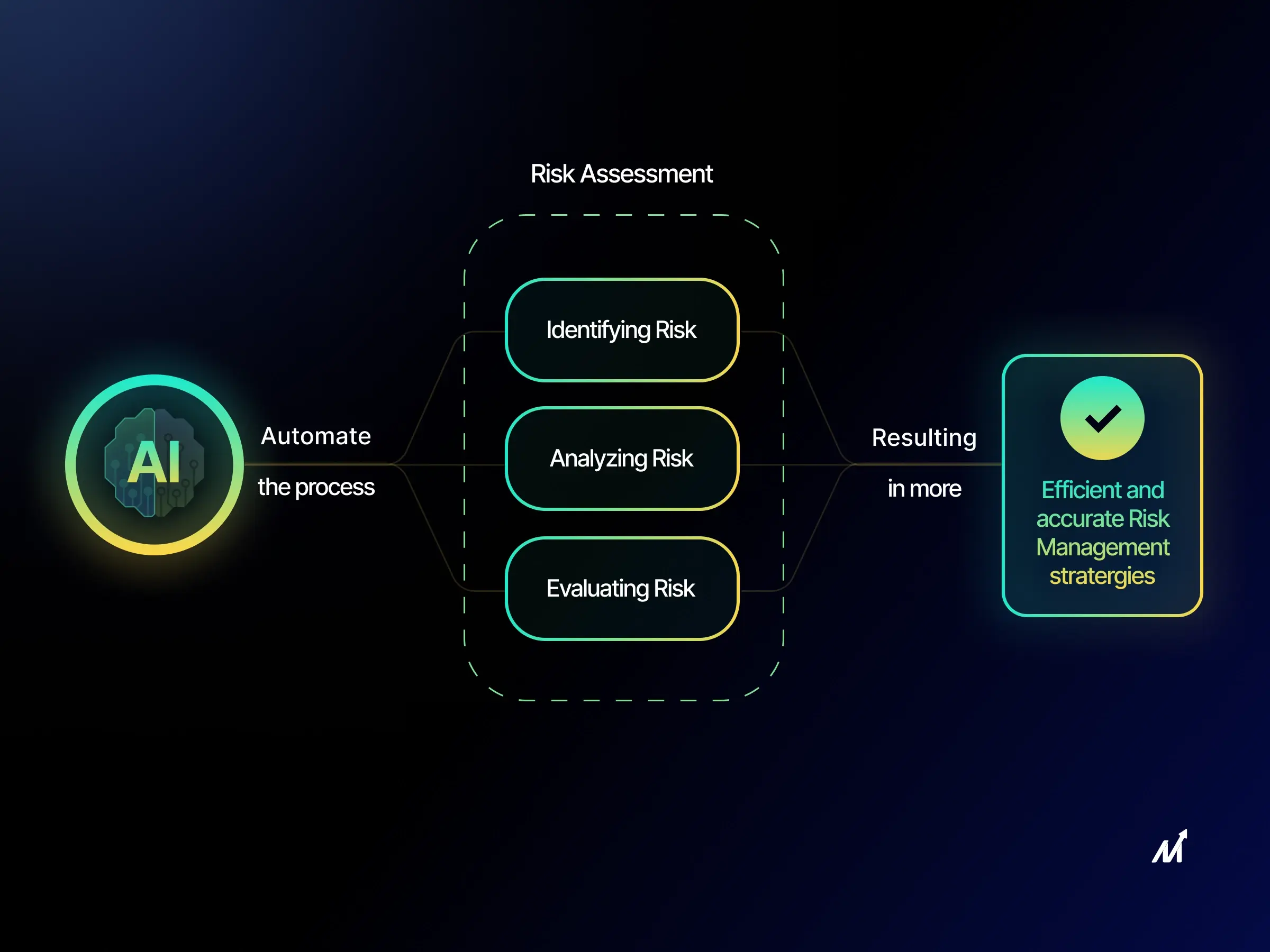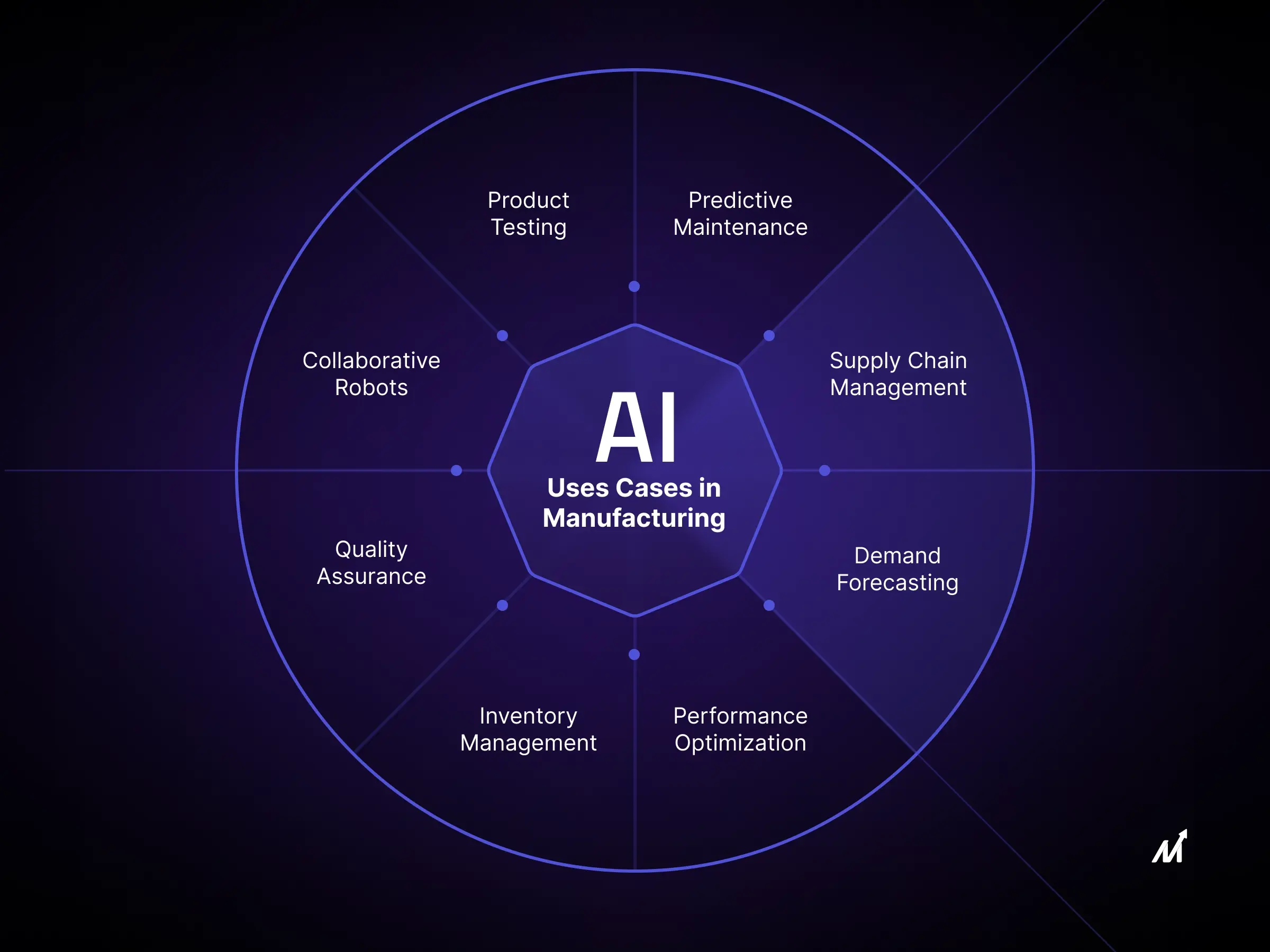In a corporate environment, adopting artificial intelligence (AI) is not just a trend but a strategic imperative. AI strategy is crucial as business leaders increasingly recognize AI’s many advantages, from enhancing employee productivity to revolutionizing customer interactions and opening new avenues for business growth.
The 2023 McKinsey global survey provides a snapshot of this trend, revealing that nearly one-third of business leaders have started employing AI in key areas such as product development, manufacturing, supply chain management, marketing, sales, service operations, finance, and human resources. Notably, this indicates that many of these adopters are exploring the potential of generative AI.
However, experts in the field, including analysts and AI consultants, point out that many organizations are only in the nascent stages of AI adoption. According to Gartner’s AI maturity model, most companies are either just becoming interested in AI or are in the early phases of experimentation and creativity, yet have yet to integrate AI fully into their strategic framework.
What do Experts have to say?
Global Deloitte AI Institute’s Executive Director, Beena Ammanath, stresses aligning AI initiatives with specific business challenges. She advocates for a strategic approach where companies address the complexities inherent in AI deployment and ensure that their AI strategies align with their broader business objectives.
Echoing this sentiment, Seth Earley, author of ‘The AI-Powered Enterprise’ and CEO of Earley Information Science, advises businesses to balance visionary thinking about AI’s potential with a pragmatic alignment of AI strategies with their business models.
Experts propose a comprehensive ten-step methodology for constructing a solid AI strategy to aid in this endeavor. This framework is designed to be applicable across various sectors, including industrial, governmental, and educational entities, ensuring that AI implementation is both strategic and beneficial.
Developing a Robust AI Framework: Insights from the Field
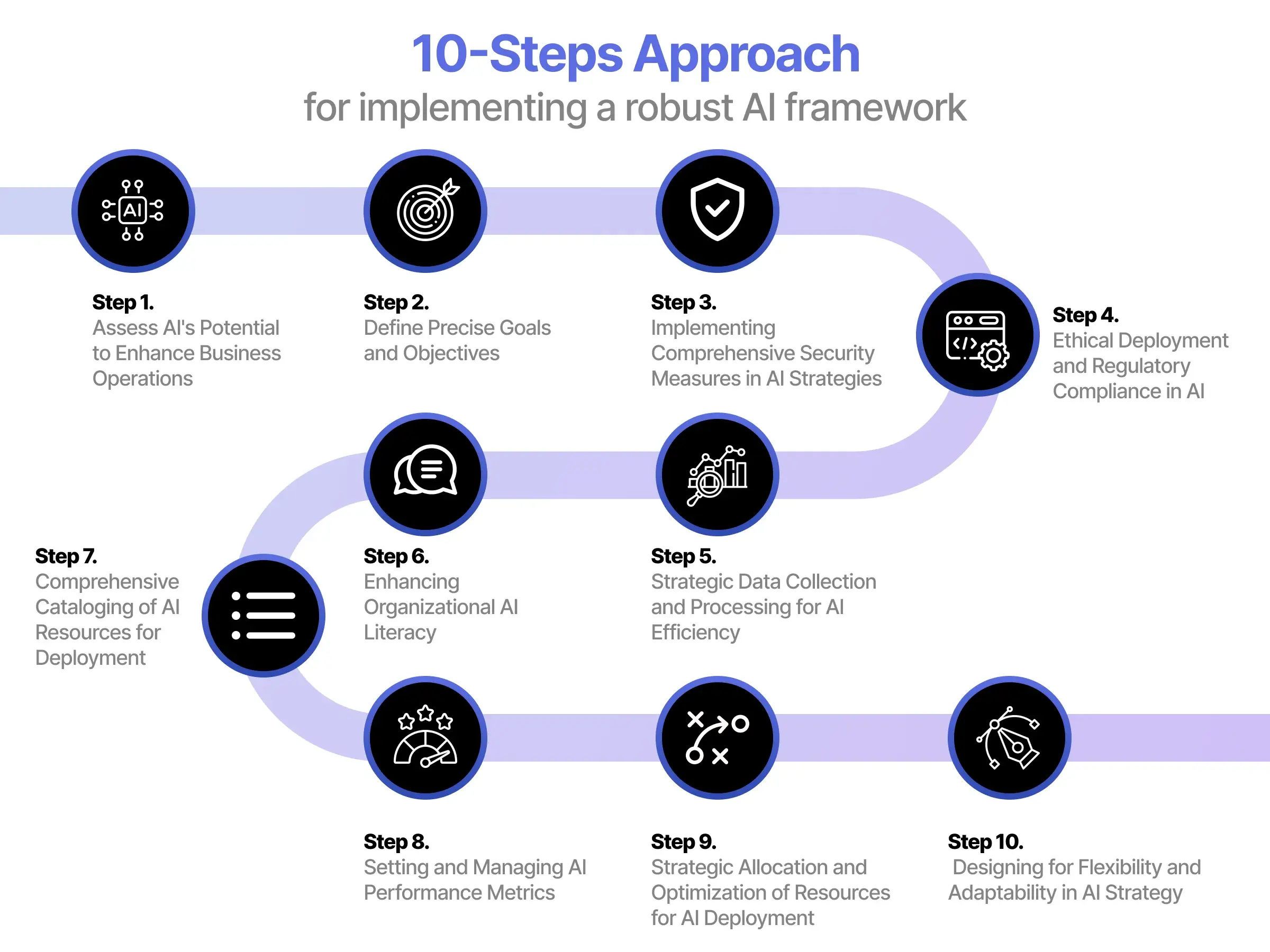
Embarking on the journey to integrate Artificial Intelligence (AI) into a business environment involves a complex interplay of elements, all aligned toward achieving core business goals.
Herein, we outline a systematic 10-step approach for implementing a robust AI framework in a business setting, emphasizing key aspects that warrant attention.
Step 1. Assess AI’s Potential to Enhance Business Operations
An initial step in devising an AI strategy is a thorough assessment of the current state of the business. This evaluation encompasses a review of data infrastructure, technological capabilities, and the expertise level of the workforce. Identifying areas within business processes that could benefit from AI-driven improvements is crucial while spotting any existing inefficiencies or vulnerabilities.
This groundwork enables a nuanced understanding of how AI could augment business operations. By mapping current processes, areas ripe for integrating automation, data analytics, and other AI-driven solutions become apparent, paving the way for enhanced efficiency and innovation.
For clarity, consider these inquiries:
- Which repetitive tasks are candidates for automation?
- Where do bottlenecks exist in our current processes?
- Can predictive analytics refine decision-making processes in certain domains?
- Concentrating on these process-oriented queries clarifies the path to tangible benefits from AI investments.
Step 2. Define Precise Goals and Objectives for AI Strategy
In framing your AI business strategy, it’s critical to establish well-articulated and concrete objectives. Pinpoint what your organization seeks to achieve with AI: elevating customer experience, streamlining operational processes, or forecasting market trends. Such clarity ensures that AI efforts are in tight alignment with these aspirations.
Adhering to the SMART (Specific, Measurable, Achievable, Relevant, Time-bound) framework is advisable. This method not only provides a clear roadmap but also facilitates the monitoring of progress.
Incorporating these AI goals within the wider business vision is equally important. This integration means that your objectives cater to immediate needs while contributing to the long-term strategic value of the business.
Enhancing and fine-tuning your strategy may benefit from engaging with AI strategy consultants. Their expertise and insights into best practices can significantly elevate the likelihood of your AI ventures’ success.
(Read more about uses cases of Generative AI)
Step 3: Implementing Comprehensive Security Measures in AI Strategies
For businesses adopting AI, it’s crucial to prioritize security from the outset. Begin by establishing a robust security framework tailored to AI systems. This involves identifying and protecting sensitive data throughout its lifecycle, from collection to processing and storage. Employ strong authentication and authorization mechanisms to control access to data and AI models, thus preventing unauthorized use. For example, a financial institution might implement multi-factor authentication and role-based access control to safeguard customer data used by AI systems.
Furthermore, it’s essential to regularly assess AI models for vulnerabilities. Conduct penetration testing and security audits to identify potential weaknesses in AI systems. This could involve simulating cyber-attacks to test the resilience of AI models against real-world threats. Additionally, develop a rapid incident response plan to address security breaches efficiently. Keeping abreast of the latest cybersecurity trends and threats is also vital. Regularly updating your security protocols and training staff on new threats ensures your AI systems are protected against evolving cyber risks.
Step 4: Ethical Deployment and Regulatory Compliance in AI
As AI technology increasingly influences decision-making, ethical deployment, and regulatory compliance become crucial. Develop an AI strategy that emphasizes transparency and ethical use. This involves clearly explaining to stakeholders and users how AI systems make decisions. For instance, if an AI is used for hiring, ensure its criteria are fair and unbiased and communicate this to all stakeholders. Regularly reviewing AI systems for ethical implications and compliance with regulations is also important. This can be done through internal audits or by consulting with external experts in AI ethics and law.
Staying updated on regulatory changes in the AI landscape is equally important. Different industries may have specific regulations governing AI use. For instance, healthcare organizations using AI must comply with HIPAA regulations for data privacy. Understanding and adhering to these regulations ensures legal compliance and builds trust with users and stakeholders.
(Read more about AI compliance)
Step 5: Strategic Data Collection and Processing for AI Efficiency
The effectiveness of AI heavily relies on the quality and diversity of data it is trained on. Businesses should develop a detailed strategy for data collection and processing. Identify various data sources that are relevant to your AI’s purpose. For example, a retail business might gather customer data from online purchases, in-store interactions, and social media activity. Ensure that the data reflects diverse inputs to avoid biases in AI decision-making.
Assess the scalability of your data collection and processing infrastructure. As your AI’s needs grow, your data handling capabilities should be able to keep pace. Implementing cloud-based data storage and processing solutions can offer the required scalability. Regularly review and update your data management practices to maintain the integrity and relevance of the data feeding into your AI systems.
Step 6: Enhancing Organizational AI Literacy
Incorporating AI into business processes necessitates an AI-literate workforce. Develop a comprehensive learning program that covers fundamental AI concepts and their application within your business context. This could include online courses, workshops, and hands-on training sessions tailored to different roles within the organization. For example, marketing teams might receive training on AI tools for customer segmentation and personalization. At the same time, IT staff might focus on AI system maintenance and security.
Partnering with educational institutions or AI consulting firms can provide structured and up-to-date learning content. This collaboration could range from guest lectures by AI experts to customized training programs for your employees. Encouraging a culture of continuous learning and curiosity about AI helps your team stay abreast of the latest AI developments and applications.
Step 7: Comprehensive Cataloging of AI Resources for Deployment
A pivotal step in formulating an AI strategy is the comprehensive cataloging of tools and technologies for deployment. Consequently, this involves a detailed inventory of platforms, frameworks, and software tailored to AI applications. Consider machine learning platforms such as TensorFlow or PyTorch, renowned for their robustness and flexibility in building complex models. Equally important are data processing systems like Apache Kafka or Hadoop, which are essential for efficiently handling large volumes of data. Moreover, this catalog should also include specialized applications for nuanced domains like natural language processing or computer vision.
The strategy should extend beyond mere listing to include a rationale for each tool’s selection. Furthermore, criteria like scalability, which ensures the system’s capacity to handle growing data volumes, community support, indicative of a vibrant, problem-solving user base, and integration capabilities, crucial for seamless operation within existing infrastructures, must be clearly outlined. A well-thought-out selection process, therefore, not only keeps stakeholders well-informed but also guarantees that the organization adopts the most suitable tools for its distinct needs, thus setting the stage for streamlined and impactful AI implementations.
Step 8: Setting and Managing AI Performance Metrics
The next critical phase is the establishment of clear, measurable performance benchmarks within your AI strategy. These benchmarks ensure that AI deployments are in lockstep with your overarching business objectives. It’s not just about setting these metrics but also managing them dynamically.
For different AI tasks, pinpoint key performance indicators. Additionally, in categorization tasks, accuracy is paramount, ensuring that the AI system correctly interprets and classifies data. In real-time systems, latency becomes a critical measure, where the speed of response can be the difference between success and failure. For search operations, precision and recall offer a more nuanced understanding of the AI’s efficiency in retrieving relevant information.
However, setting these benchmarks is just the beginning. Regular review and adjustment of these benchmarks are imperative. Moreover, this should be based on actual outcomes and evolving business needs. It’s a dynamic process, adapting to the ever-changing landscape of AI technology and market demands. By establishing and managing these performance metrics, you uphold a consistent standard for AI quality, enabling educated decisions about model adjustments and further deployment.
Step 9: Strategic Allocation and Optimization of Resources for AI Deployment
For successful AI deployment, a comprehensive strategy for resource allocation is essential. Therefore, this phase involves a meticulous approach to distributing resources like personnel, budget, and infrastructure to effectively support every aspect of AI deployment.
1. Identifying Requisite Expertise
Begin by assessing the skills necessary for your AI initiatives. This might involve different strategies, such as hiring new AI specialists with specific expertise, training and development programs for current staff to elevate their AI capabilities, or forming strategic partnerships with external AI strategy consulting firms. The objective is to assemble a team with a diverse range of skills that are crucial for the successful execution of AI projects.
2. Evaluating Infrastructure Needs
The next step is ensuring that the hardware and software infrastructure is adequately equipped to support your AI projects. Consequently, this could mean investing in high-performance computing clusters, which are essential for efficiently processing large volumes of data or considering cloud services for their scalability and flexibility. The infrastructure should meet current requirements and be scalable to accommodate future growth.
3. Budget Allocation and Management
Forecasting the financial demands of your AI projects is critical. Therefore, develop a comprehensive budget that covers all aspects of technology procurement, talent acquisition, and unforeseen challenges. Include a contingency fund for unexpected expenses. Additionally, ensure there’s room for continuous learning, system upgrades, and maintenance. The budget should be a living document, regularly reviewed and adjusted as project needs evolve.
4. Resource Optimization
Finally, optimize the use of allocated resources. This involves ensuring that every dollar spent and every hour invested contributes to the effective implementation of AI in your organization. Additionally, regularly assess resource utilization to identify areas of inefficiency or waste and make adjustments as needed. This helps streamline operations and maximize the return on investment in AI technologies.
By meticulously planning these aspects, you pave the way for a resource-optimized, efficient AI deployment. Consequently, this strategic allocation and optimization ensure that each resource contributes to successfully implementing and scaling AI within your organization.
Step 10: Designing for Flexibility and Adaptability in AI Strategy
The AI landscape is characterized by its dynamic and rapidly evolving nature. Therefore, crafting an AI strategy that is flexible and adaptable is not just advantageous but necessary. This phase focuses on building a strategy framework that can effortlessly pivot as required by new developments or shifting paradigms in AI technology.
Establish regular review points within your strategy. These checkpoints are vital for assessing the strategy’s effectiveness in light of the latest technological advancements, market changes, and internal business shifts. Moreover, fostering a culture of feedback from all stakeholders, including AI developers, end-users, and business leaders, helps identify areas for improvement and fine-tune the strategy accordingly.
By embedding flexibility and adaptability into your AI strategy, you ensure that it remains relevant and effective. Therefore, even in the face of rapid changes in the AI ecosystem, this prepares your organization to respond to emerging opportunities and actively capitalize on them.
Loved it? Read about Developing AI system from scratch once strategy is ready.
Foundational Pillars of AI Strategy
The four foundational elements of an effective AI strategy are crucial for businesses seeking impactful advancements:
1. Strategic Vision for AI Strategy
Pinpointing the strategic opportunities presented by generative AI or other AI technologies is vital. While generative AI is a burgeoning field, a minority of organizations have succeeded substantially through its deployment across various business sectors and operations. Although constituting only a small percentage of AI experimenters, these frontrunners offer valuable insights for aspiring adopters of generative AI.
Generative AI promises to revolutionize current economic and social structures, echoing the transformative effects of the internet and earlier innovations like electricity. For enterprises, the pivotal question is how AI aligns with and propels their broader goals, yielding enhanced results. Hence, effectively implemented, generative AI can be a game-changer, enhancing competitive edge and differentiation. It leverages AI’s inherent capabilities to automate routine tasks. Moreover, it sparks novel concepts, insights, and innovations through predictive analytics, machine learning, and AI methodologies.
Potential impacts of generative AI on shareholder value include:
1. Revenue Growth
AI assists businesses in rapidly developing new products. In addition, sectors like pharmaceuticals, healthcare, and manufacturing will emerge as AI-centric industries, innovating in areas like drug development, eco-friendly cleaning products, new flavors and fragrances, advanced alloys, and improved medical diagnostics.
2. Enhanced Customer Engagement
Generative AI can disrupt existing value chains and business models, enabling direct consumer content distribution and improving customer interaction.
3. Cost Reduction and Productivity Enhancement
GenAI simplifies processes and accelerates outcomes, augmenting human efforts in content summarization, classification, software coding, and chatbot optimization. It also capitalizes on previously untapped data resources.
4. Measuring AI Success
Insights from a comprehensive Gartner survey of over 600 AI-deploying organizations reveal that the most experienced and comprehensive AI users do not gauge success by sheer project quantity or outputs. Instead, they prioritize:
- Business Metrics over Financial Metrics: They employ specific attribution models and ad hoc measures tailored to each case.
- Internal and External Benchmarking: This involves comparing performance against both internal standards and external competitors.
- Early Identification and Consistent Measurement of Metrics: Success is assessed swiftly and uniformly for AI applications.
Key business metrics focus on aspects like
- Business Growth: This includes measures such as cross-selling potential, pricing strategies, demand forecasting, and monetizing new assets.
- Customer Success: Indicators here involve retention rates, customer satisfaction, and customer wallet share.
- Cost Efficiency: Metrics include inventory management, production costs, workforce productivity, and asset utilization.
Further Gartner studies indicate that AI teams defining success metrics are significantly more likely to employ AI strategically. When setting these metrics, the AI team should integrate input from data managers, business analysts, domain experts, risk management leaders, data scientists, and IT professionals.
2. Maximizing Value in AI Strategy
The second fundamental component of an effective AI strategy emphasizes the elimination of obstacles to fully leveraging AI’s potential:
Maximizing AI Value
Embracing the full scope of AI’s capabilities goes beyond just adopting tools like ChatGPT. Executives should adopt a holistic view that encompasses business value, risk assessment, talent acquisition, and investment prioritization, all while preparing for the potential upheaval of current business models and strategies.
Historically, AI’s business value has predominantly arisen from isolated solutions. Organizations may need to undertake comprehensive business process transformations to derive greater, scalable benefits, particularly from generative AI (GenAI) projects. This could involve developing new skill sets, establishing novel roles and organizational structures, and adopting innovative work methodologies. Inaction or resistance to change could significantly diminish the opportunities identified through AI.
GenAI is set to disrupt traditional roles, skills, and processes. Consequently, organizations must strategize how they will adapt their processes and systems and upskill their workforce as GenAI becomes integral to everyday operations. Furthermore, AI’s thoughtful and future-oriented deployment will be a key differentiator between enduring success and potential failure.
Gartner’s strategic forecasts suggest:
- By 2026, more than 100 million individuals will interact with robot colleagues (virtual synthetic colleagues) in enterprise environments.
- By 2033, AI solutions aimed at augmenting or autonomously executing tasks, activities, or roles are predicted to create over half a billion net new human jobs.
Overcoming Adoption Hurdles
It is essential to identify and address factors that may hinder the adoption of GenAI projects or constrain the ability to harness their full value. Additionally, this involves developing strategies, defining actionable steps, and appointing a dedicated executive to lead the required organizational change. For instance, if an organization faces challenges in data literacy, which is critical for driving AI projects, including executives—not just employees—in data literacy training and initiatives is imperative. Assigning the Chief Data and Analytics Officer (CDAO) the responsibility to spearhead this program and ensure the participation of other executives can be an effective approach.
3. Assessing Risks in AI Strategy
The third pillar of a robust AI strategy is a thorough preparation for assessing and mitigating a spectrum of AI-associated risks. Moreover, this aspect is becoming increasingly important as AI technologies advance and become more integrated into various sectors. These AI-related risks include:
1. Regulatory Risks
AI introduces legal complexities, particularly with the potential for copyright or protected content violations. Rapid regulation changes necessitate a keen awareness of local and jurisdiction-specific AI laws to ensure compliance. Additionally, sectors like life sciences and financial services may face unique industry-specific regulations.
2. Reputational Risks
The potential for AI to perpetuate biases and the opacity of some AI systems (“black box” issues) can create significant reputational challenges. Furthermore, lack of transparency in training datasets from vendors may lead to undesirable outcomes. Moreover, untested AI services could result in suboptimal decision-making or task execution. Organizations must establish strong safeguards to protect intellectual property and customer data, particularly when developing or procuring generative AI services.
3. Competency Risks
AI demands a distinct skill set, which organizations must cultivate by upskilling current employees or recruiting talent from academia or startups. Skills such as prompt engineering and responsible AI are becoming increasingly vital.
Beyond these, AI threats and compromises are ongoing and evolving challenges, whether malicious or unintentional. Establishing principles and policies for AI governance, focusing on aspects like trustworthiness, fairness, reliability, robustness, efficacy, and privacy, is essential. Failure to do so increases the likelihood of adverse AI outcomes and breaches, leading to performance issues, security and privacy failures, financial and reputational damage, and potential harm to individuals.
The Gartner AI TRiSM framework underscores the importance of solutions, techniques, and processes for model interpretability and explainability, privacy, model operations, and resistance to adversarial attacks. Moreover, a cross-functional team or task force, including legal, compliance, security, IT, data analytics, and business representatives, is recommended to optimize results from AI initiatives.
This framework delineates the crucial elements of AI risk, trust, and security management for safely integrating AI into an organization.
Specific Risks of Generative AI
When generating new content, strategies, designs, and methods from extensive source repositories, generative AI may lead to:
- False Outputs: Issues with stability, reasoning accuracy, context comprehension, limited explainability, trackability, and inherent biases.
- Security Concerns: The storage of confidential information in public applications could lead to its use in training new model versions, risking the exposure of sensitive data and intellectual property to external users, including malicious entities.
- Legal Risks: Generative AI poses legal challenges related to intellectual property, privacy concerns, copyright infringement, trade secret misappropriation, data privacy, model bias, and model security.
4. Strategic Implementation of AI
This is all about Aligning Use Cases with Business Impact and Practicality
When determining use cases for AI, inclusive of GenAI applications, business unit leaders must define the clear, tangible benefits they anticipate. Thus, this involves addressing key questions:
- Identifying the specific challenge the business intends to resolve.
- Recognizing the principal users of the technology.
- Determining the business operation that will incorporate the AI technique.
- Engaging experts within the business lines to steer solution development.
- Establishing methods for assessing the impact and ongoing value of the technology, along with responsible parties for monitoring and maintenance.
1. Initial Experimentation: A Prerequisite
Embarking on a comprehensive AI strategy without first trailing its components is premature. Therefore, adopting a systematic, five-step methodology can effectively introduce AI techniques:
- Case Selection: Develop a collection of impactful, quantifiable, and swiftly resolvable use cases.
- Talent Pool: Form a team with skills relevant to these cases.
- Data Accumulation: Collect necessary data pertinent to the chosen cases.
- Technological Alignment: Choose AI methods that align with the cases, skills, and data.
- Organizational Framework: Organize and integrate the acquired AI expertise.
This approach advocates for a tactical, quick-to-benefit methodology rather than a long-term strategic plan.
2. Weighing Feasibility Against Business Value
The initial step of identifying the most beneficial use cases should focus on specific improvement initiatives with clear business impacts. Therefore, feasibility is a critical factor in this process.
Generally, the potential for higher returns is associated with high-risk and low-feasibility projects. However, unfeasible endeavors with current technology and data resources are not worth pursuing, regardless of their perceived business value.
Essential Considerations for Introducing AI Techniques:
- Use Cases: Determining relevant applications.
- Skills: Ensuring the right talent is in place.
- Data: Securing appropriate data sources.
- Technology: Selecting suitable AI methodologies.
- Organization: Establishing an effective AI knowledge structure.
Feasibility is assessed based on:
- Technical Capability: The ability of existing technology to enhance the business use case to a leading-edge level.
- Internal Factors: Organizational culture, leadership support, skill availability, and ethical considerations.
- External Factors: Regulatory environment, societal acceptance, and external infrastructural elements.
A use case that significantly contributes to business value and is easily feasible is indicative of either a groundbreaking development or an overlooked market opportunity.
3. Impact of Data Strategy on AI Project Feasibility
Given AI’s heavy reliance on data, employing GenAI without integrating it into the existing data framework limits its effectiveness. Moreover, a well-defined data management and governance strategy, focusing on data quality and trustworthiness, reduces data acquisition costs and facilitates capturing essential data needed to power AI initiatives.
Markovate: Offering AI Strategies with Tailored Business Needs
At Markovate, we specialize in transforming business landscapes with AI-driven strategies precisely engineered to meet your industry needs. Specifically, our approach is not about implementing generic AI solutions; it’s about architecting a bespoke AI framework that seamlessly integrates into your business model, propelling growth and innovation.
For businesses set to start or advance in AI, we offer:
- Custom AI Integration: We analyze your business DNA to architect AI solutions that are not just advanced but are a perfect fit for your unique challenges and goals.
- Efficiency through Automation: Our AI systems are designed to automate and optimize your key processes, reducing operational costs while enhancing productivity.
- Data-Driven Decision-Making: We unlock the power of your data, employing sophisticated AI analytics to provide insights that drive strategic decision-making and competitive advantage.
- Empowering Your Team: Beyond technology, we focus on people. We equip your team with the skills and tools necessary to leverage AI, ensuring your organization is AI-fluent and future-ready.
In partnering with Markovate, you’re choosing a path of targeted innovation and sustained growth, leveraging AI not just as a tool but as a cornerstone of your business strategy.
FAQs (Answering AI Strategy Framework Concerns)
1. What Are the Key Components of an Effective AI Strategy Framework?
An effective AI strategy framework encompasses clear goals, data governance, technology infrastructure, talent acquisition, and ethical considerations. Therefore, setting specific, measurable goals aligned with your business objectives is crucial. Equally important is establishing robust data governance to ensure quality and compliance. Investing in the right technology infrastructure to support AI initiatives and acquiring talent with the necessary skills are essential steps. Moreover, integrating ethical guidelines to address AI’s societal impact is vital for sustainable growth.
2. How Can Our Business Identify the Most Beneficial AI Applications?
To identify beneficial AI applications, start by analyzing your business processes and pinpointing areas where AI can add value, such as automating routine tasks, enhancing customer experiences, or providing data-driven insights. Additionally, prioritize applications that align with your strategic objectives and offer a clear return on investment. Consult with AI experts to understand the feasibility and potential impact of different AI solutions in your specific industry context.
3. What Are Common Challenges in Implementing AI and How Can We Overcome Them?
Common challenges include data quality issues, lack of expertise, integration complexities, and ethical concerns. However, overcome these by ensuring access to high-quality, relevant data and investing in data cleaning and preparation. Additionally, building or hiring a skilled team with AI expertise is crucial. Work closely with IT teams to ensure smooth incorporation of AI into existing systems for integration. Furthermore, address ethical issues by developing a framework considering fairness, transparency, and accountability in AI applications.
4. How Should We Measure the Success of Our AI Initiatives?
Success measurement should be based on specific, pre-defined metrics that align with your business goals. Additionally, these include improved efficiency, cost savings, revenue growth, customer satisfaction, or innovation benchmarks. Furthermore, regularly review these metrics to assess the performance of your AI initiatives. It’s also important to consider qualitative feedback from stakeholders to understand the broader impact of AI on your organization.
5. Can AI Strategy Evolve Over Time, and How Do We Adapt?
Yes, AI strategy should evolve in response to technological advancements, market changes, and internal business growth. Additionally, stay informed about emerging AI trends and technologies. Regularly reassess and adjust your strategy to reflect new opportunities or shifting business priorities. Moreover, encourage a culture of continuous learning and flexibility within your organization to adapt to changes swiftly and effectively.


